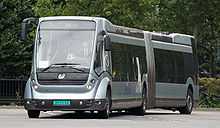Phileas (public transport)


Phileas is a bus rapid transit, developed by Samenwerkingsverband Regio Eindhoven (SRE), Netherlands, along with some other companies for the Cooperation Foundation Eindhoven Region (most prominently; APTS and Bombardier). It is an advanced guided bus intended to deliver tram-like public transport at a very low cost: the infrastructure is much cheaper, because of less maintenance, and there are no rails and overhead lines. The biggest feature of the bus is the recharging of the battery by means of electromagnetic induction; which means that the battery can be made much smaller, and thus less heavy and environmentally damaging.[1][2] The project was created in the late 1990s; there was a wish to demonstrate the high technology level and technical knowledge in the Eindhoven area and to create jobs. The project has cost more than one billion euros, including infrastructure changes.
Origin of name
Phileas is called after Phileas Fogg, the protagonist in Around the World in Eighty Days by Jules Verne because of the high speed and ability to be on time.
Navigation
The Phileas mainly drives on a bus lane. The navigation consists of a pre-programmed route, which is verified by using magnets built into the road. The used technique FROG assures that the buses are able to drive automatically, though a driver is always present - the budget prevented the Phileas from being completely separated from ordinary traffic, so a driver is needed under Dutch law. For some years the regional authority for urban transport in Eindhoven (SRE) decided not to use the magnetic guidance system any more.
Safety
The computer system inside the Phileas buses is designed according to Safety Integrity Level SIL-4. It controls the vehicle's speed and direction and has a triple-redundant, fail-safe architecture. This means that one system consists of three single-board computers in a 2-out-of-3 configuration. Each is installed in a different place in the bus, so as to avoid a complete system failure in case of a vehicle collision. Every single computer obtains data from all sensors via two CAN bus connections and compares them with the other two computers' results. As soon as data are different, the bus is switched off and the entire system goes into safe state, which means that the bus stops and opens its doors.[3]
License
On November 3, 2005 a license & technology transfer agreement was signed between Advanced Public Transport Systems (APTS) and the Korea Railroad Research Institute (KRRI). KRRI develops the Korean version of Phileas vehicle by May 2011.[4]
In December 2009, APTS, the manufacturer of the Phileas Tram, signed a contract with Ballard Fuel Cells of Vancouver to supply zero emission engines for the Phileas.
The Phileas Trams are in successful operation in The Netherlands, France, Turkey and Korea, and Israel.[5]
Challenges of the Metrobus project in Istanbul
Istanbul Metropolitan Municipality purchased 50 Phileas bi-articulated vehicles for the Metrobus project. Due to overcrowding on vehicles (as many as 300 passengers were being crammed into trams that originally had been designed for 185), and the hilly terrain of Istanbul, the Phileas bus needed modifications to the axles. Changes were made to accommodate the higher passenger traffic.
See also
External links
| Wikimedia Commons has media related to APTS Phileas. |
- www.apts-phileas.com
- PhileasNews
- Ballard Power of Vancouver signs with APTS to power Phileas Trams
- Phileas in Istanbul (Turkish)
Sources
This article incorporates parts of the Dutch Wikipedia entry, nl:Phileas (OV)
References
- ↑ Electromagnetic recharging
- ↑ Phileasbus using electromagnetic induction
- ↑ "Driverless Bus Guidance Computer System". MEN Micro. Retrieved 2010-09-21.
- ↑ Bimodal Transportation Research Center
- ↑ See Metronit article.
- ↑ Another electric bus with recharging system at bus stops (bottom)
- ↑ TOSA2013 The project aims to introduce a new system of mass transport with electric “flash” recharging of the buses at selected stops (overhead conductive charging)